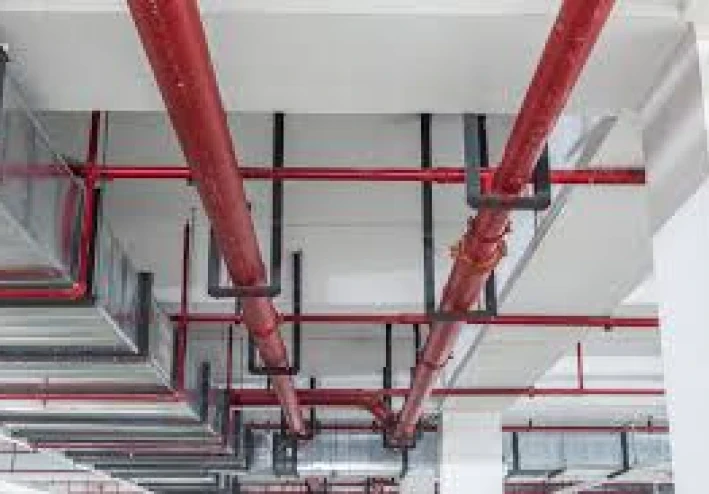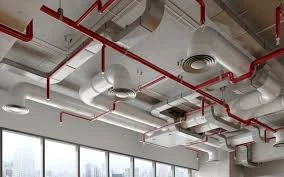
Conflict Between HVAC Ducts and Fire Sprinkler Pipes
The space above the suspended ceiling (the Ceiling Plenum) in modern facilities represents a critical envelope for accommodating Mechanical and Electrical Plumbing (MEP) systems. A recurrent engineering challenge arises from the clash between the pathways of Heating, Ventilation, and Air Conditioning (HVAC) Ducts and the routing of Fire Sprinkler Pipes. This interference not only impacts architectural aesthetics and reduces the net ceiling height but, more critically, it can compromise the functional performance of the fire protection network, a life-safety critical system.
This analysis aims to identify the systematic engineering causes of this conflict and present a set of effective design and execution solutions to resolve it.
I. Root Engineering Causes of Service Conflicts
The clash between ductwork and fire suppression piping primarily stems from the overlap in the horizontal and vertical utilization of the constrained service space:
1. Interdisciplinary Coordination Deficiency
This is the most frequent contributing factor. Duct pathways (designed by the HVAC engineer) and fire system routes (designed by the Fire Protection engineer) are often initially developed in isolation. The absence of a 3D Coordination Process, typically utilizing tools like Building Information Modeling (BIM), leads to the discovery of these intersections only during the on-site construction phase, where the cost and time of rework are significantly escalated.
2. The Physical Volume of HVAC Ducts
The main ducts of a central air conditioning system necessitate large dimensions (a significant cross-sectional area) to ensure appropriate Air Flow Rate with minimal Pressure Drop and reduced noise generation. Despite efforts to minimize height by using wide, rectangular ducts (low aspect ratio), the overall size often creates a vertical obstacle that interferes with the piping network.
3. Strict Legislative Constraints of Fire Systems (Code Compliance)
Global codes (such as NFPA) impose rigid requirements on the positioning of Sprinklers, mandating that they provide a defined Coverage Pattern without obstructions to water discharge. Due to the priority of this life-safety system, fixed Elevations (Mantasib) are established for pipe runs and sprinkler heads, thus restricting the movement of ductwork which must often change elevation to avoid blocking coverage.
4. Required Engineering Slopes for Piping
Certain fire pipes (especially in wet pipe systems utilizing black steel) require specific Slopes to ensure air purging or drainage. This vertical gradient along the run conflicts with the straight horizontal nature required for effective duct routing.
II. Methodological Solutions for Achieving Horizontal and Vertical Harmony
Resolving this conflict necessitates a proactive approach that begins in the early design stages to ensure efficient execution and operation:
1. Adopting Building Information Modeling (BIM) Technology
The adoption of BIM technology is the most robust solution. By designing all services within a single digital model, specialized software can perform Clash Detection automatically. Once conflicts are identified, engineers can:
Re-route Pathways: Adjusting the horizontal path of the duct or pipe.
Determine Vertical Priority: Giving elevation priority to the system with the strictest vertical constraints (typically fire piping due to sprinkler head elevation).
2. Mechanical Solutions in Duct Design
Low-Profile Cross Section: At inevitable intersection points, the duct width can be increased at the expense of its height to create a Low-Profile Duct, allowing it to pass beneath or above the fire pipe without significantly violating the overall ceiling height.
Duct Splitting: When a major fire pipe obstructs a main duct run, the large duct can be split into two smaller Branch Ducts that bypass the pipe, reconvening into a single main run after the point of conflict.
Penetration through Structural Beams (Sleeve Penetration): With prior coordination with the structural engineer, Reinforced Sleeves can be incorporated into concrete Beams (Kamarat) to allow large HVAC ducts to pass through. This preserves vertical clearance beneath the beams for the fire piping.
3. Design Solutions for the Fire System Network
Flexibility in Branch Routing: Secondary fire system branches should be designed with greater flexibility to adjust their horizontal path, while maintaining priority for the routes of main lines and Risers whose relocation is more complex.
Fixing Sprinkler Elevation: Sprinkler heads are mounted at a defined fixed elevation. The routing of main pipes and branches is established entirely based on this elevation as a non-negotiable "Bottom Line."
4. Execution Oversight and Quality Control
Systematic Installation Sequence: A precise installation sequence must be established. Typically, the mounting of the main supports for the largest elements occurs first, followed by the other services in an order that adheres strictly to the elevations defined in the final coordination drawings.
Engineering Verification of Elevations: Surveying equipment and leveling tools must be used to ensure that the installation elevation of every service (especially the bottom of ducts and the bottom of fire pipes) corresponds precisely with the approved technical blueprints.
Conclusion
The successful integration of HVAC and fire suppression systems in the ceiling plenum hinges on proactive planning and comprehensive engineering coordination. Moving beyond isolated design and adopting technological tools like BIM is essential to "solve the problem on paper" before it becomes a costly and disruptive challenge on the construction site. Maintaining the efficiency of fire protection systems, while ensuring optimal HVAC performance and preserving architectural height, represents the paramount objective of any engineering services






































